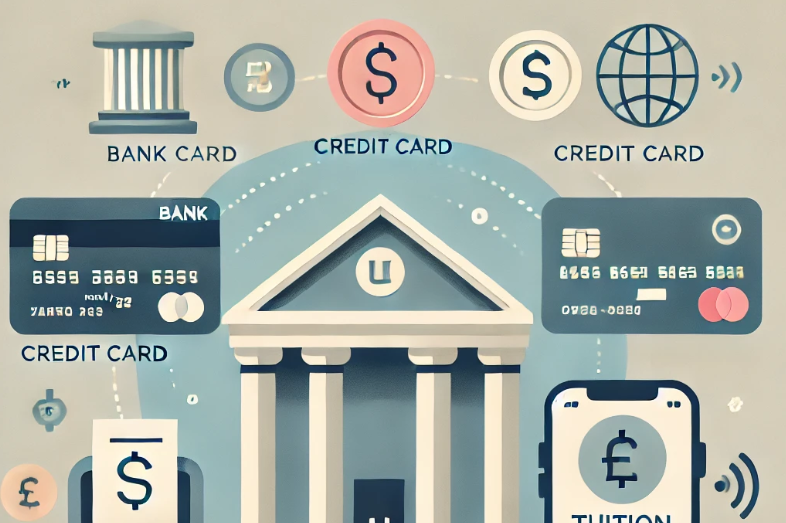- Remittance
- Exchange Rate
- Stock
- Events
- EasyCard
- More
- Download
What Are the Best Ways to Pay Tuition Fees for Studying in the UK? How to Choose the Most Economical
The UK, with its world-class education quality and rich cultural heritage, attracts countless international students. However, tuition fees are often a major concern for students and parents. In addition to tuition fees, living expenses, visa fees, and insurance costs are also significant expenses.
Therefore, choosing the most suitable payment method is crucial as it can save costs and ensure a safe and convenient payment process.

Common Payment Methods
When paying tuition fees for studying in the UK, students face several options, each with its unique advantages and disadvantages. Here are some common payment methods and a detailed analysis of each:
Bank Wire Transfer
Process: Students can transfer tuition fees directly to the school’s account through a bank. This requires providing the school’s bank account number, bank code, and other relevant information.
Advantages:
- High Security: Bank wire transfers are generally very secure as transactions through the banking system are strictly regulated.
- Suitable for Large Payments: Bank wire transfers are ideal for large tuition payments, ensuring substantial funds reach their destination safely.
Disadvantages:
- Long Processing Time: Bank wire transfers usually take a few days to complete and can be delayed by intermediary banks.
Credit Card Payment
Process: Students can use a credit card to pay tuition fees through the school’s online payment system or other payment platforms.
Advantages:
- Convenient and Fast: Credit card payments are usually instant and easy to operate.
- Payment Protection: Most credit card companies offer payment protection services, allowing refunds in case of problems.
Disadvantages:
- High Fees: Credit card payments usually incur high fees, especially for cross-border transactions which may also involve foreign exchange fees.
- Interest Charges: If the credit card bill is not paid off in time, high interest charges will accrue.
Online Payment Platforms
Process: Use online payment platforms such as Flywire or BiyaPay to pay tuition fees. Some platforms collaborate with schools to provide dedicated payment channels.
Advantages:
- Low Fees: Online payment platforms typically charge lower fees and offer favorable exchange rates.
- Convenient: The payment process is simple and fast, suitable for quick payments.
- Multiple Currency Support: Supports the conversion and payment of multiple currencies, convenient for international students.
Disadvantages:
- Platform Restrictions: Not all schools accept all online payment platforms, so confirmation is needed in advance.
- Payment Limits: Some platforms may have single or daily payment limits, making them suitable for small transfers.
Recommended BiyaPay: Supports large transfers with fees as low as 0.5%, enables local transfers in most regions and countries worldwide, achieving same-day transfers. It also supports real-time conversion of cryptocurrencies such as BTC and USDT to mainstream fiat currencies like USD and GBP, which is very friendly for cryptocurrency users.
Check Payment
Process: Students can pay tuition fees by mailing a check. This requires contacting the school’s finance department for detailed payment information.
Advantages:
- Simple: For students unfamiliar with online payments or bank transfers, check payment is a straightforward option.
- No Fees: Usually, check payments do not involve fees.
Disadvantages:
- Long Processing Time: Mailing and processing checks take a long time, which may delay payment.
- Low Security: Checks can be lost or stolen, requiring extra caution.
Money Transfer Services
Process: Use money transfer services like Western Union or MoneyGram to pay tuition fees. These companies usually provide offline outlets globally for quick transfers and receipts.
Advantages:
- Fast Processing: Electronic transfers can usually be completed within minutes to hours, suitable for urgent payments.
- Globally Available: These services have outlets in most parts of the world, convenient for students and parents to use.
Disadvantages:
- High Fees: Money transfer services have relatively high fees.
- Limits: Some services may have limits on the amount that can be transferred per transaction or per day.
By understanding the advantages and disadvantages of various payment methods, students can choose the most suitable payment method based on their needs and specific circumstances, ensuring a smooth payment process and saving costs.
How to Choose the Most Economical Payment Method
Exchange Rates and Fees: Bank transfers and electronic remittances have market exchange rates but involve foreign exchange fees; credit card payments also have high fees. Online payment platforms like BiyaPay have low fees, suitable for frequent remittances.
Security and Convenience: Bank transfers and credit card payments are highly secure, regulated by financial authorities. Online payment platforms like BiyaPay also have multiple security measures and have obtained financial licenses in many countries. Credit card payments and online payments are easy and fast, not restricted by time.
Processing Time: Bank transfers and electronic remittances across countries take a few days; credit card payments and online payment platforms like BiyaPay are usually instant.
Conclusion
Choosing a suitable payment method is crucial for UK students. Different payment methods have their advantages and disadvantages in terms of exchange rates, fees, security, and convenience. Through reasonable selection and planning, students can effectively manage their study expenses, making their study life smoother and more enjoyable.
I hope this introduction and suggestions provide useful information and help to students.

























